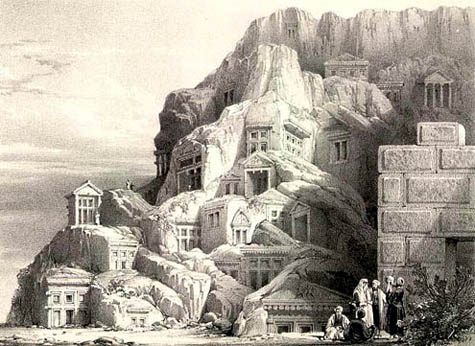Crowned with a towered wall
 [Image: Tombs atop tombs atop tombs, cut directly from mountain bedrock, in an engraving by John Murray called "Rock Tombs, near the Theatre at Myra" (1841); published in An Account of Discoveries in Lycia by Charles Fellows. Fellows's "explorations in the interior and the south [of what is now Turkey] led him to districts practically unknown to Europeans, and he thus discovered ruins of a number of ancient cities," Wikipedia explains].
[Image: Tombs atop tombs atop tombs, cut directly from mountain bedrock, in an engraving by John Murray called "Rock Tombs, near the Theatre at Myra" (1841); published in An Account of Discoveries in Lycia by Charles Fellows. Fellows's "explorations in the interior and the south [of what is now Turkey] led him to districts practically unknown to Europeans, and he thus discovered ruins of a number of ancient cities," Wikipedia explains].In his classic travel diary published in 1841, British archaeologist Charles Fellows referred to the site pictured above as "a rocky mountain, crowned with a towered wall of early Greek construction"—it was a "fortified mountain... excavated with Lycian tombs."
While traveling to the location through a series of inexplicably rugged ravines, he added:
- A few miles before we arrived at the termination of the ravine, several remains of Greek-built towers rose from amidst the trees, on the points of rocks, apparently inaccessible; and at the opening of the ravine commenced the cutting of an aqueduct in the face of the perpendicular cliff, which we traced on our right hand to the ancient city. In following its now broken course, numbers of highly ornamented tombs caught my eye, and promised full occupation for a day or two's sojourn amongst them.
Inside this labyrinth of interconnected rock-cut tombs in what was then called Asia Minor, surrounded by partially painted statues sculpted out of the hillsides themselves and told by a local Greek priest that it would take at least three years to see all of the region's ruins, the archaeologist proceeded to set up camp and sleep.
(Spotted via Takeo Kamiya—see previous post).





Comments are moderated.
If it's not spam, it will appear here shortly!
Post a Comment